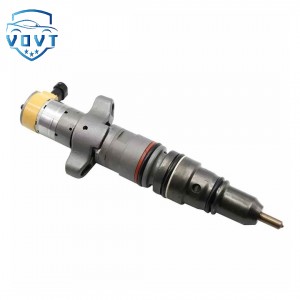New High Quality Diesel Injector 172-5780 188-8739 217-2570 235-2887 235-2888 236-0962 10R-7224 For CAT C9
Products Description
| Reference. Codes | C9 |
| Application | C9 |
| MOQ | 4PCS |
| Certification | ISO9001 |
| Place of Origin | China |
| Packaging | Neutral packing |
| Quality Control | 100% tested before shipment |
| Lead time | 7~10 working days |
| Payment | T/T, L/C, Paypal, Western Union, MoneyGram or as your requirement |
Introduction to the function of fuel injector
Accurately control the amount of fuel injection
Function: According to the working conditions of the engine (such as idling, acceleration, high-speed driving, etc.), accurately adjust the injection amount to keep the air-fuel ratio (mass ratio of air to fuel) always within the ideal range (theoretical air-fuel ratio is 14.7:1).
Idle condition: small amount of fuel injection, maintain the lowest stable speed;
Full load condition: maximum amount of fuel injection, provide sufficient power;
Deceleration condition: reduce or stop fuel injection, reduce fuel consumption and emissions.
Principle: ECU obtains real-time engine data through sensors (such as air flow meter, throttle position sensor, crankshaft position sensor, etc.), calculates the required amount of fuel injection, and then sends an electrical signal to the injector to control the injector opening time (injection pulse width) - the longer the opening time, the more fuel injection.
Ensure the quality of fuel atomization
Function: Atomize liquid fuel into fine particles (about 50-100 microns in diameter), expand the contact area between fuel and air, promote uniform distribution and full combustion of mixed gas, reduce carbon deposits, and improve combustion efficiency.
Principle: There are precise needle valves and spray holes inside the injector. When the fuel is sprayed out through the spray hole under high pressure (the pressure of the manifold injection system is about 3-5bar, and the pressure of the direct injection system in the cylinder can reach 100-350bar), it is broken into mist due to high-speed flow and air impact.
Key structure:
Electromagnetic coil: generates a magnetic field after power is turned on, sucks up the needle valve, and opens the injection channel;
Pressure spring: pushes the needle valve to close when the power is off to prevent fuel leakage.
Work with different injection methods
Depending on the engine type and fuel injection technology, the installation position and working mode of the injector are divided into two categories:
1. Manifold injection (intake port injection)
Installation position: located near the cylinder head of the intake manifold, and each cylinder corresponds to an injector.
Working characteristics:
The fuel is sprayed into the intake manifold before the intake stroke, mixed with air in the intake port to form a mixed gas, and then enters the cylinder.
The injection pressure is low (3-5bar), and the requirements for fuel cleanliness are relatively low.
Representative models: some naturally aspirated engines (such as early Toyota and Honda models).
2. Direct injection (GDI)
Installation location: directly inserted into the cylinder head to spray fuel into the combustion chamber.
Working characteristics:
The fuel is directly sprayed into the high-temperature and high-pressure cylinder during the compression stroke, mixed with air and ignited and burned.
The injection pressure is extremely high (100-350bar), the spray hole is smaller (about 0.1-0.3 mm in diameter), and the fuel quality and injector accuracy are required to be higher.
Representative models: mainstream turbocharged engines (such as Volkswagen EA888, Buick LSY, etc.).
IV. Improving engine performance and emission compliance
Increasing power output:
Precise injection amount and good atomization effect can ensure more complete combustion, release more energy, and increase engine torque and power (especially direct injection technology, which can achieve stratified combustion and further optimize power).
Reduce fuel consumption:
Through real-time calculation of the ECU, fuel waste is avoided (such as reducing fuel injection at idle speed), "supply on demand" is achieved, and fuel consumption per 100 kilometers is reduced.
Reducing pollutant emissions:
Uniform mixture combustion is more complete, which can reduce the generation of harmful gases such as CO (carbon monoxide) and HC (hydrocarbons), and meet environmental regulations (such as National VI and Euro VII standards).
Key performance indicators of injectors
Injection pressure: determines the atomization effect of the fuel. The higher the pressure, the finer the atomization (direct injection in the cylinder > manifold injection).
Response speed: The power-on/power-off speed of the electromagnetic coil determines the opening/closing delay of the injector. High-speed response can ensure precise control under transient conditions such as rapid acceleration.
Flow consistency: The injection amount error of each cylinder injector must be less than 5%, otherwise it will cause uneven combustion of each cylinder, causing engine shaking, power imbalance and other problems.
Sealing: When closed, the fuel channel must be completely blocked to prevent fuel dripping (which may cause difficulty in starting, unstable idling or flooding).
Impact of injector failure on the engine
If the injector is blocked, leaked, or has poor atomization, it may cause:
Starting difficulties: the fuel cannot be injected normally, and the mixture is too lean or too rich;
Idle jitter: the amount of fuel injected in each cylinder is uneven, and the combustion is unbalanced;
Acceleration weakness: insufficient injection or poor atomization during rapid acceleration, and power output lags;
Increased fuel consumption: incomplete fuel combustion, or continuous leakage of the injector causes excessive fuel to enter the cylinder;
Excessive emissions: increased unburned fuel and harmful gases, and unqualified exhaust gas detection;
Increased carbon deposits: poor atomization causes fuel to adhere to the intake valve or cylinder wall, forming carbon deposits.























